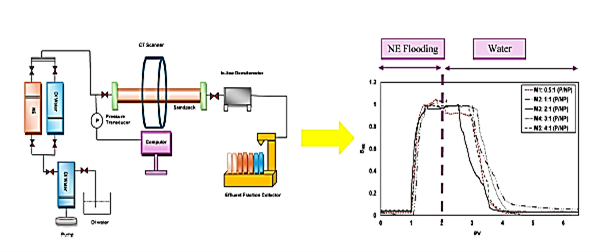Magnetic Nanoemulsion Transport
Understanding how engineered nanofluids behave in porous media is essential for subsurface diagnostics and enhanced oil recovery. This study investigates magnetic Pickering nanoemulsions (MPNs) emulsions stabilized by polymer-coated iron oxide nanoparticles—and their transport dynamics through sandpack systems. These MPNs offer dual benefits of magnetic traceability and structural stability, making them ideal candidates for advanced subsurface applications. Published in Colloids and Surfaces A: Physicochemical and Engineering Aspects, the work evaluates how varying polymer-to-nanoparticle ratios affect nanoemulsion mobility, retention, and stability.
The experiments involved injecting different MPN formulations into CT-scanned sandpacks, monitoring displacement using pressure drops, saturation profiles, and magnetic susceptibility measurements. Effluent analysis, including droplet size distribution and concentration profiles, provided additional insights into nanoparticle behavior during and after flooding.
Key Takeaways
- Higher polymer-to-nanoparticle ratios (4:1, 3:1) enhanced emulsion stability and reduced nanoparticle retention.
- CT scans showed piston-like, uniform nanoemulsion flow with full saturation at 1.4 PV injection.
- Magnetic susceptibility confirmed effective displacement with minimal nanoparticle retention.
- Increased polymer content lowered IFT and improved droplet dispersion, optimizing flow through porous media.
This study demonstrates MPNs' promise as tracers or smart fluids in subsurface energy applications.

